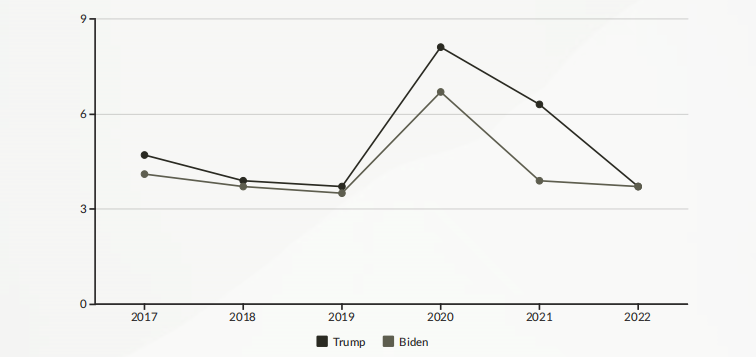TRUMP VS BIDEN
Comparing the growth and economy
This presentation will delve into the economic policies of Donald Trump and Joe Biden, contrasting their approaches and analyzing their impact on the U.S. economy.

GDP Growth under Trump and Biden
The U.S. economy experienced significant growth under both President Trump and President Biden, though at varying rates. During Trump’s presidency (2017- 2021), the annual average GDP growth was 2.5%, while under Biden (2021- present), it has averaged 2.1%.
| Trump | Biden |
| 2.5% | 2.1% |

Unemployment Rates under Trump and Biden

Unemployment rates have historically fluctuated. However, the pandemic of 2020, under Trump, saw a drastic rise. Biden’s presidency experienced a sharp decline in unemployment, reaching pre-pandemic levels.
Trade Policies and Tariffs under Trump and Biden
Trump’s Protectionist Approach
Trump implemented tariffs on goods from China, Mexico, and other countries, aiming to protect American industries and jobs.
Biden’s Focus on Multilateralism
Biden has sought to rebuild relationships with allies and address trade issues through multilateral agreements.
Impact on Global Trade
Trump’s tariffs sparked trade wars, while Biden’s approach has focused on resolving trade disputes through diplomacy
Tariffs on Specific Goods
Both presidents have imposed tariffs on certain goods, such as steel and aluminum, to protect domestic producers.
Tax Reforms under Trump and Biden

Trump's Tax Cuts and Jobs Act
The Tax Cuts and Jobs Act of 2017 reduced corporate tax rates, expanded standard deductions, and adjusted individual income tax brackets.

Biden's American Rescue Plan
The American Rescue Plan Act of 2021 extended tax credits for child care and expanded the Earned Income Tax Credit.

Impact on the Economy
Both reforms aimed to stimulate economic growth, but their long-term effects on tax revenue and income inequality are still being debated.
Regulations and Business Environment under Trump and Biden
Deregulation under Trump
Trump focused on reducing regulations across industries, aiming to boost business growth and job creation. He eased environmental rules, financial regulations, and labor regulations.
Business-Friendly Policies
Trump’s tax cuts and deregulation policies were seen as favorable to businesses. He also promoted trade deals to open new markets for U.S. companies
Impact on Economic Growth
The impact of Trump’s policies on economic growth is debated. Some argue that deregulation spurred growth, while others claim it led to market instability.
Biden’s Focus on Regulation
Biden has reversed some of Trump’s deregulation efforts, focusing on environmental protection, consumer safety, and labor rights.
Infrastructure Investments under Trump and Biden
Trump's Focus on Roads and Bridges
Trump’s infrastructure plan prioritized investments in roads, bridges, and airports. He aimed to increase spending on traditional infrastructure, seeking to improve the nation’s physical infrastructure.
Biden's Focus on Broadband and Green Energy
Biden’s infrastructure plan included a significant focus on expanding broadband access, investing in clean energy, and upgrading water systems. He aimed to address climate change and digital inequities.
Energy and Environmental Policies under Trump and Biden
Trump's Emphasis on Fossil Fuels
Trump sought to promote the development of fossil fuels, rolling back environmental regulations and supporting the construction of pipelines.
Biden's Focus on Clean Energy
Biden has prioritized clean energy investments, seeking to transition away from fossil fuels and reduce greenhouse gas emissions.
Environmental Regulations
Trump weakened environmental regulations, while Biden has strengthened them, including measures to address climate change.
International Agreements
Trump withdrew from the Paris Agreement on climate change, while Biden rejoined it.
Impact on the Stock Market under Trump and Biden
Trump’s Bull Market
The S&P 500 index, a benchmark of U.S. stock performance, rose significantly during Trump’s presidency, driven by tax cuts and deregulation.
Early Gains Under Biden
The stock market continued its upward trajectory in the early months of Biden’s presidency, benefiting from the economic recovery.
Market Volatility and Uncertainty
The market has experienced volatility in recent years, influenced by factors such as inflation, interest rate hikes, and geopolitical events.
Conclusion: Evaluating the Economic Performance and Outlook
The economic policies of Presidents Trump and Biden have had distinct impacts on the U.S. economy. While both presidencies have seen periods of growth and challenges, their approaches to issues such as trade, taxes, and regulations have resulted in varying outcomes.
The long-term implications of these policies continue to unfold, and their impact on future economic performance remains to be fully understood.
Trump and Biden Seek Re-election
Both former President Donald Trump and current President Joe Biden are expected to run for office again. Trump, the Republican candidate, plans to focus on economic nationalism and immigration. Biden, the Democratic incumbent, will likely highlight his government experience and appeal to a wide range of voters.
The upcoming election promises to be a significant moment in American politics, as voters weigh the merits of each candidate’s vision for the country. The outcome could have far-reaching consequences for the nation’s future.
